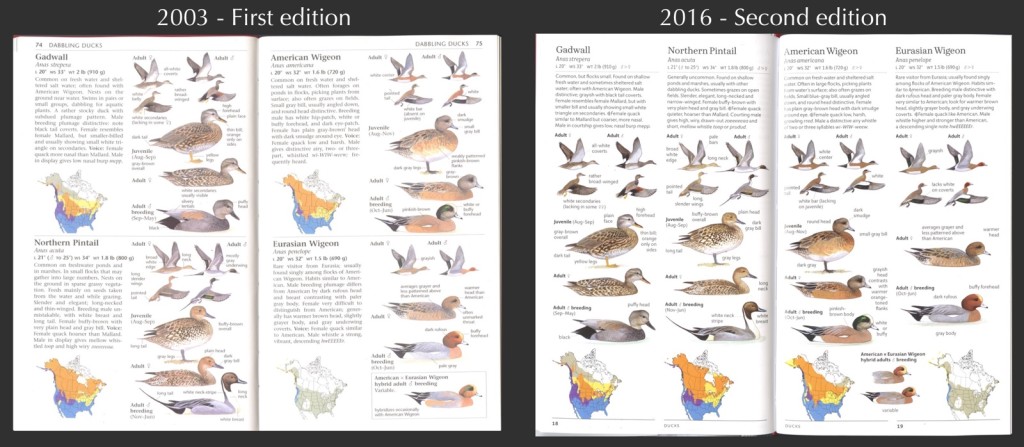The new second editions of the Eastern and Western Field Guides use the revised art, text, and maps from the Second Edition of the Sibley Guide to Birds (see this page for info about what was changed in that book).
The new editions are the same size as the 2003 versions, but the layout is changed to match the format of the larger Sibley Guide to Birds, with each species in a vertical column – name at the top, map at the bottom, etc. – making comparisons much easier.
And these books even have some revisions beyond what was included in the second edition of the Sibley Guide to Birds (2014). The text of many species is updated to reflect specific details for eastern or western observers. Taxonomic changes since 2014 are included, such as the split of Ridgway’s Rail. Several introduced species are added. Pin-tailed Whydah is added to both books based on breeding records in California and Florida, and Japanese White-eye, Cinnamon-rumped Seedeater, Bronze Mannikin, and Orange-cheeked Waxbill are added to the Western Guide based on records in California.
New and improved features include:
- Updated habitat, description, behavior, and conservation text for each species account and all family pages.
- New and revised illustrations of species and regional forms.
- New design featuring species accounts in columns, allowing for better comparison and more illustrations and text.
- Current taxonomic order and up-to-date common names.
- All maps revised to reflect the most current range information.
- More species and rarities included



David, just thought I would add a few comments regarding your Sibley guides. In all honesty, I feel your artwork stands above all others. In addition, your clear text, descriptions, etc., all stands above the rest. I am not sure you will publish again, since most birders, especially newcomers depend on apps. But, if you do, other than incorporating the latest taxonomy changes, please increase the text size just a little as well as increase the painting sizes even just a little bit. My only other suggestion is a quick index in the front of the book or something similar. It is much quicker to get to the bird you want in a National Geographic guide. Please take that as constructive criticism. Your guides are still number one with me.
Sincerely, Kerry Grim, Hamburg, PA
Thank you for all of your work over the years, I find your guides the most helpful. I own your Guide to Birds, Sibley Birds East, and when my dad moved to New Mexico a year ago, I bought him the Sibley Birds West guide and it’s already well-loved.
I found an inconsequential typo, and due to some personal problem can’t seem to avoid mentioning it – in my copy of Sibley Birds West, Second Edition, published in 2016, on page 414, the description of the “Red-backed Adult” has “Junco” spelled with an “m”. The full phrase is “Red-backed form of Dark-eyed Jumco.”
So sorry to bother you over nothing, but I can’t imagine editing a book with this amount of detail, I hoped it could be helpful if you plan on releasing another edition.